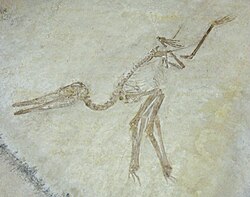Aurorazhdarcho
|
Aurorazhdarcho Temporal range: Late Jurassic, 150 Ma |
|
|---|---|
 |
|
| Specimen formerly referred to Pterodactylus longirostris, Muséum national d'histoire naturelle in Paris | |
| Scientific classification | |
| Kingdom: | Animalia |
| Phylum: | Chordata |
| Class: | Reptilia |
| Order: | †Pterosauria |
| Suborder: | †Pterodactyloidea |
| Family: | †Ctenochasmatidae |
| Genus: |
†Aurorazhdarcho Frey, Meyer & Tischlinger, 2011 |
| Species: | †A. micronyx |
| Binomial name | |
|
Aurorazhdarcho micronyx (von Meyer, 1856) |
|
| Synonyms | |
|
Pterodactylus nettecephaloides |
|
Pterodactylus nettecephaloides
Ritgen, 1826 (nomen oblitum)
Ornithocephalus redenbacheri
Wagner, 1851 (nomen oblitum)
Pterodactylus micronyx
von Meyer, 1856
Pterodactylus pulchellus
von Meyer, 1861
Aurorazhdarcho primordius
Frey et al., 2011
Aurorazhdarcho is an extinct genus of ctenochasmatidpterosaur known from the Late Jurassic of Bavaria, southern Germany.
A specimen originally classified as Pterodactylus micronyx (now Aurorazhdarcho micronyx) was one of the earliest, if not the earliest, documented pterosaur fossil ever found. The holotype specimen of P. micronyx, also known as the "Pester Exemplar", was originally part of the private fossil collection held by Archduchess Maria Anna of Austria. Evidence suggest that the Pester Exemplar was unearthed at some point between 1757, when Maria Anna was recovering from serious cases of pneumonia and tuberculosis, after which she began collecting fossils, and 1779, when the specimen was first studied by scientists. This overlaps with the possible time of discovery of the holotype specimen of Pterodactylus antiquus, often considered the first pterosaur found, which was unearthed sometime between 1767 and 1784.
The Pester Exemplar consists of a jumbled and partially dis-articulated juvenile pterosaur skeleton lacking a skull. Because of this, and the unusual (and at the time totally unknown) anatomy of pterosaurs, the specimen was originally misidentified as a decapod crustacean when it was first studied by Ignaz von Born, a prominent Enlightenment naturalist. In 1871, the specimen was sold, along with the rest of Maria Anna's collection, to the Royal Hungarian University of Buda in Hungary, from which it was later transferred to the collection of Pest University when the university relocated. (In 1950, the name of the university changed again to Eötvös Loránd University).
...
Wikipedia
